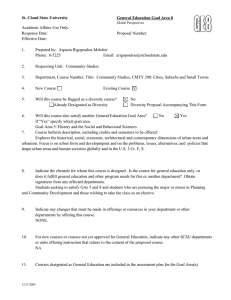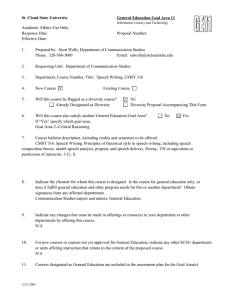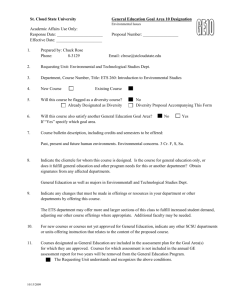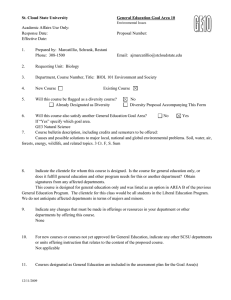St. Cloud State University General Education Goal Area 8
advertisement
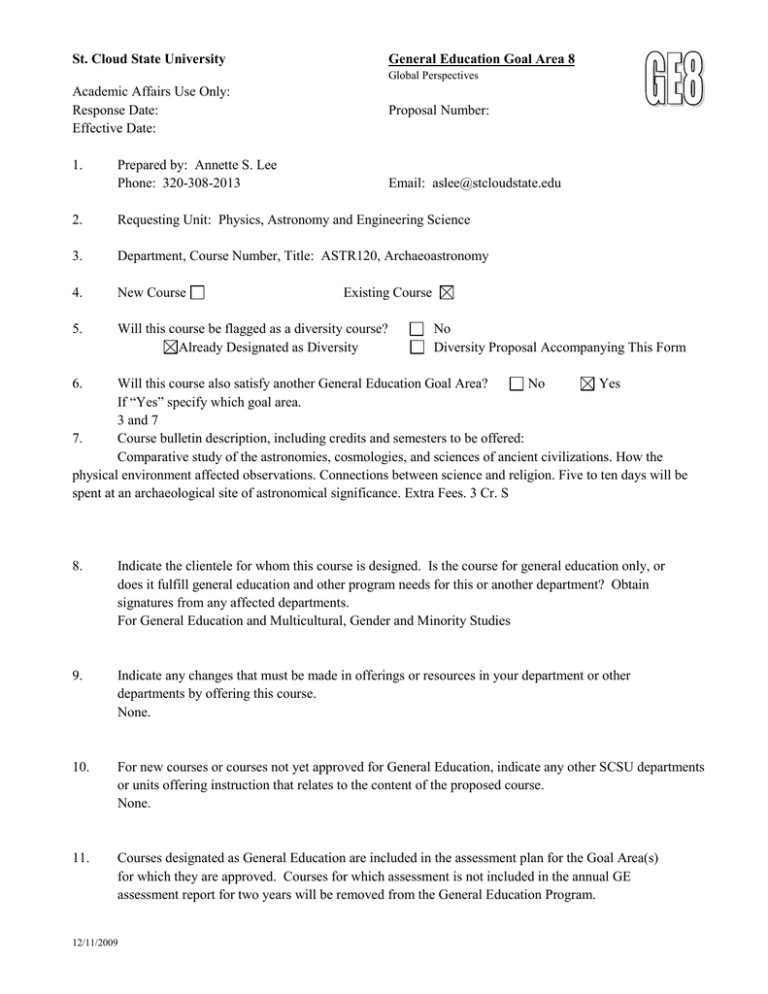
St. Cloud State University General Education Goal Area 8 Global Perspectives Academic Affairs Use Only: Response Date: Effective Date: 1. Proposal Number: Prepared by: Annette S. Lee Phone: 320-308-2013 Email: aslee@stcloudstate.edu 2. Requesting Unit: Physics, Astronomy and Engineering Science 3. Department, Course Number, Title: ASTR120, Archaeoastronomy 4. New Course 5. Will this course be flagged as a diversity course? Already Designated as Diversity Existing Course No Diversity Proposal Accompanying This Form 6. Will this course also satisfy another General Education Goal Area? No Yes If “Yes” specify which goal area. 3 and 7 7. Course bulletin description, including credits and semesters to be offered: Comparative study of the astronomies, cosmologies, and sciences of ancient civilizations. How the physical environment affected observations. Connections between science and religion. Five to ten days will be spent at an archaeological site of astronomical significance. Extra Fees. 3 Cr. S 8. Indicate the clientele for whom this course is designed. Is the course for general education only, or does it fulfill general education and other program needs for this or another department? Obtain signatures from any affected departments. For General Education and Multicultural, Gender and Minority Studies 9. Indicate any changes that must be made in offerings or resources in your department or other departments by offering this course. None. 10. For new courses or courses not yet approved for General Education, indicate any other SCSU departments or units offering instruction that relates to the content of the proposed course. None. 11. Courses designated as General Education are included in the assessment plan for the Goal Area(s) for which they are approved. Courses for which assessment is not included in the annual GE assessment report for two years will be removed from the General Education Program. 12/11/2009 The Requesting Unit understands and recognizes the above conditions. 12. Provide a concise explanation of how the following goal is a “significant focus” of the proposed course. Goal Area 8: Global Perspectives Develop a comparative perspective and understanding of one’s place in a global context. The primary objective of this course is to use astronomy as a vehicle to develop an understanding of native cultures, past and present, and how they are similar to and different from our modern civilization. 13. In order for a course to be designated as fulfilling Goal Area 8, it must address at least 4 of the 5 student learning outcomes (SLOs) below. Check the SLOs below that are focused on in the proposed general education course. 1. Explain how they are connected and related to people elsewhere in the world. 2. Describe similarities and differences among global places and populations. 3. Analyze how political, economic or cultural elements influence relations among the world’s states, peoples, or societies. 4. Analyze specific international issues and propose and evaluate responses. 5. Articulate a vision of their individual roles and responsibilities in a common global future. 14. Discuss how each Student Learning Outcome checked above is achieved in this course. (Note: Although descriptions of typical assignments or types of assignments may be part of this discussion, it is not appropriate to submit copies of actual assignments.) A major focus of student participation during class time, writing assignments and exams is on demonstrating an understanding of how various aspects of environment, societal need, and religion influence the development of astronomy and science in each of the civilizations. (SLO 3) This work builds an appreciation for the diversity of influences not only on a given subject, but on the society, culture and people of the civilization. (SLO 2) Hence, the students come to see the development of astronomy in terms of what appears to have been important to that civilization, and not in terms of the major influences in our daily lives. (SLO 1) This course brings out and compares the questions that various individual civilizations were asking about the physical world and seeks to identify why these questions were posed. (SLO4) From class discussion, reading and writing assignments, students draw their own conclusions about the relative importance of various influences on the civilization in general and the astronomy and science of that civilization in particular. Students demonstrate critical thinking that will be used to communicate their personal place and future goals in their own community. (SLO 5) 12/11/2009 15. List or attach the Course Outline (adequately described and including percentage of time to be allocated to each topic). Curriculum Committees may request additional information. Topics larger than 20% need to be broken down further. Indicate in your course outline where the Student Learning Outcomes checked above are being met. COURSE OUTLINE: I. Scientific Astronomical Topics 30% - SLO 1, 2, 3, 4, 5 The Sky Above 10% Planets 5% Stars 5% Galaxies 5% Cosmologies 5% II. Native American Astronomy Plains Woodlands Southwest Mayan/Aztec III. Other Astronomies Chinese Egyptian European Australian Indian/Tibet 12/11/2009 50% - SLO 1, 3, 4, 5 15% 15% 10% 10% 20% - SLO 1, 2, 3, 4, 5 4% 4% 4% 4% 4% St. Cloud State University General Education Transmittal Form Academic Affairs Use Only: Response Date: Effective Date: Proposal Number Department: Physics, Astronomy and Engineering Science Course or Course(s): ASTR 205 Kevin L. Haglin Department or Unit Chair Signature 2/25/2010 Date Department forward to Academic Affairs for publication and electronically to Chair of General Education Committee, Chair of College Curriculum Committee, College Dean Recommendation of General Education Committee: Approve Remarks: Disapprove Chairperson Committee Signature Date Recommendation of University Curriculum Committee: Approve Remarks: Disapprove Chairperson Committee Signature Date Recommendation of Faculty Association: Approve Remarks: Disapprove FA Senate Signature Date Action of Academic Vice President: Approve Disapprove Signature Entered in Curriculum Data File 12/11/2009 Remarks: Date
